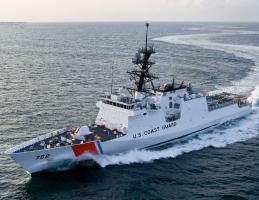 We recently posted about a budget proposal by the current administration which would drastically cut the US Coast Guard’s budget. While the budget proposal is unlikely to survive in its current form, it does suggest a fundamental lack of an understanding of the critical role that the Coast Guard plays in our national security. Within a few days of the budget proposal’s release, Coast Guard Commandant Admiral Paul Zukunft, in his annual State of the Coast Guard speech at the National Press Club in Washington, addressed why the Coast Guard should be expanding, rather than cutting its operations and its fleet.
We recently posted about a budget proposal by the current administration which would drastically cut the US Coast Guard’s budget. While the budget proposal is unlikely to survive in its current form, it does suggest a fundamental lack of an understanding of the critical role that the Coast Guard plays in our national security. Within a few days of the budget proposal’s release, Coast Guard Commandant Admiral Paul Zukunft, in his annual State of the Coast Guard speech at the National Press Club in Washington, addressed why the Coast Guard should be expanding, rather than cutting its operations and its fleet.
One part of the budget proposal would cut the ninth national security cutter to be built at Huntington Ingalls Industries for a savings of roughly $500 million. Admiral Zukunft pointed out that the national security cutter Hamilton intercepted 26 metric tons of cocaine on its first patrol, showing that the ship “more than pays for itself in less than 100 days.” He also noted that the The newest NSC, the James, is on track to replicate that in its first patrol. The street value of the cocaine seized by the Hamilton has a street value of over $2 billion. Last year, cutters and aircraft working together seized over 200 metric tons of cocaine.
While the new cutters give the the Coast Guard new tools to effectively do their job, the rest of the fleet is still underfunded and often antiquated. In recent years, the US Coast Guard has had only two operational icebreakers, one of which is more than 40 years old. According to Homeland Security Department research, the U.S. needs three heavy and three medium icebreakers to be able to break ice 365 days a year. The Coast Guard is now teaming up with the Navy to begin the process to build new icebreakers. They are not close to cutting steel yet, however. At the end of February, the Coast Guard the U.S. Coast Guard awarded five engineering contracts for heavy polar icebreaker design studies and analysis, totally approximately $20 million.
In addition to the rebuilding the icebreaker fleet, the the cutter and tender fleet on the inland and coastal waterways needs attention. Of the inland fleet of 35 cutters, 25 are more than 50 years old, with the oldest being 73. Admiral Zukunft suggested that the time to replace this legacy – or perhaps geriatric class of cutters, as he referred to them, – arrived over a decade ago.
Thanks to Mary Habstritt for contributing to this post.

A fine POST. Thanks Rick!
And Mary Habstritt of course who contributed this story.
Living on an island off the coast of Massachusetts as I do, means that the maritime world, in all its facets, is constantly unfolding around us. We have a Coast Guard Station here and it is very busy with all sorts of activities. Drug interdiction is only a limited part. There are lots of other activities from maintaining aids to navigation, to Search and Rescue, to routine patrols, ice patrol, and so much else. The men and women of the Coast Guard should be provided with the resources they need to get the job (often hazardous) done. For Trump to cut back on the Coast Guard (13%) while upping the budget dramatically for the other services is unconscionable. We who live in maritime communities, whether coastal on on inland waters, as well as those offshore deserve the very finest. Remember the saying: “you do have to go out, you don’t have to come back?” Think about it. If anyone wants to know about courage, bravery and devotion to duty watch (YouTube) the 11 minute video of the rescue by CG helicopter, of the BOUNTY crew.
Hear, hear — well said!